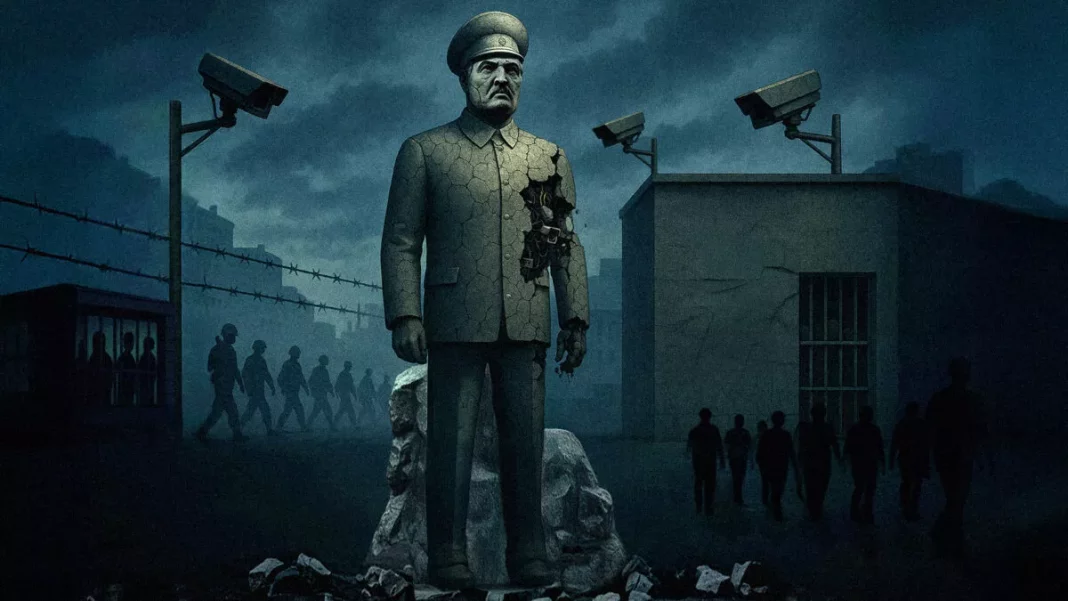By EUvsDisinfo
On 9 August 2020, Aleksandr Lukashenka unleashed a massive reprisal against thousands of Belarusians who dared to stand up against his decades-long rule, marching in unprecedented, peaceful mass protests. Despite massive repression and violence, hundreds of thousands of Belarusians demonstrated to demand free and fair elections.
This public uprising was a true shock for Lukashenka. After five years, he continues to be haunted by the ‘nightmare’ of the 2020 protests. Already then, it was obvious that the Belarusian dictator had lost all remnants of domestic political legitimacy. Since August 2020, Vladimir Putin has become the only ‘guarantor’ of Lukashenka’s ‘legitimacy’ as the Russian president assured his Belarusian ally that Russian security services would ‘intervene if the Belarusian protests got out of control’.
Lukashenka’s ongoing ‘war on Belarusians’ is carried out through the persecution of 2020 protesters, enhancement of control of society through fear and ‘silent terror’, and a drift towards a totalitarian regime.
‘Everyone will be punished’
In 2025, five years after the large-scale protests, Lukashenka continues to be driven by an irrational fear of the Belarusians who stood up against his rule. He seems to want to punish literally every person who showed disloyalty by taking part in the protests, commenting online, or financially supporting pro-opposition initiatives.
Since 2020, Belarusian law enforcement agencies have turned into a repression machine, systematically looking for ‘traitors’. According to the ‘Viasna’ Belarusian Human Rights Centre, between 2020 and 2024, over 74,000 Belarusians faced different types of political repression. Some 65,000 persons were detained and the rest suffered fines and dismissals from their workplaces. As of July 2025, at least 8,519 persons have faced criminal prosecution. Today, at least 1,191 political prisoners are still in detention.
Lukashenka’s repression machine has not stopped. So far in 2025 alone, the regime has detained 183 new political prisoners, with 29 detained in June alone. On average, the regime has imprisoned one new political prisoner every day.
There is widespread evidence that Belarusian political prisoners face physical and psychological torture, malnutrition, and a lack of access to proper medical assistance. One terrible illustration was the condition of Siarhei Tsikhanouski when he was released. Even his own daughter did not recognise him after five years in prison.

Source: https://nashaniva.com/ru/370761
The spread of total fear through ‘silent terror’
In the past five years, life in Lukashenka’s Belarus has started to resemble Stalinist times, with everyday arrests, widespread denunciations, advanced surveillance, ‘traitor’ paranoia within the state administration, lists of ‘enemies of the state’, and ‘purges’ of state services and enterprises.
Through these actions, Lukashenka clearly wants to impose on the society an atmosphere of total fear. Citizens understand that they will be heavily punished for even minor acts of political disloyalty, such as a subscription to an ‘extremist’ Telegram channel. Lukashenka’s policy of ‘silent terror’ communicates to the Belarusian people that they should subordinate themselves totally to the state or face repression.
According to the BelPol initiative, Lukashenka’s security services use a database of ‘enemies of the state’ called ‘BESporiadki’ (‘Riots’), which includes over 100,000 individuals suspected of participating in the 2020 protests. The very name of the database dehumanises its members. In the Russian language, ‘BES’ means ‘demon’. All persons listed have limited civil rights. They cannot work for state institutions, they are regularly detained for ‘preventive talks’, and their mobile phones are randomly checked.
Besides the BESporiadki, authorities are also using another database – of ‘disloyal’ persons. It includes Belarusians who put their signatures in support of pro-democracy candidates’ nominations for the 2020 elections. In total, almost half a million Belarusians may appear on Lukashenka’s ‘enemy of the state’ lists.
As a result of repression, between 300,000 and 500,000 Belarusians have decided to move to exile, fleeing the despotic policies of Lukashenka.
Drift towards a ‘semi-totalitarian’ regime
After 2020, Lukashenka took a number of steps towards strengthening his grip on Belarus. As a result, his regime has transformed into a much harsher dictatorship, or even into a semi-totalitarian state. Lukashenka does not see the need to fake the existence of democracy in the country anymore. In 2024, he publicly called his regime a ‘dictatorship of stability, security and order’.
In the past five years, the Belarusian dictator has fully purged the political landscape of the country, leaving only four officially registered puppet parties and liquidating hundreds of independent NGOs and media outlets.
Today, Lukashenka’s political opponents are legally labelled as ‘extremists’ and ‘terrorists’, the state considers ‘insulting officials’ or ‘discrediting the Army’ to be criminal offenses, and a wide range of pretexts allows imposing the death penalty for ‘high treason’.
Lukashenka’s political regime has gradually turned into a harsh dictatorship with visible totalitarian traits that include mass repression, systematic torture, total information control, and the full liquidation of political and civilian freedoms.
Hostage trading
Since July 2024, Lukashenka has turned to his old political trick – trading political prisoners. Most recently, in June-July 2025, around 30 political prisoners were released, including opposition leader Siarhei Tsikhanouski and a number of foreign citizens. With this gesture, Lukashenka tried to persuade American authorities that ‘he was ready for talks with the West’.
In reality, Lukashenka has repeatedly carried out this trick of ‘trading in air’ in the past three decades. He has an endless supply of political hostages as his repression machine does not stop. So far, there are no indications that Lukashenka is willing to stop his war on Belarusian society.
Intensification of state propaganda
Besides widespread repression and intimidation, Belarusian authorities have visibly intensified their propaganda efforts after the 2020 protests, reaching not only schools, but even kindergartens.
According to Lukashenka, state-run media outlets should be the population’s only source of information. As such, after 2020, he carried out a thorough purge of independent outlets in the country, destroying literally all uncontrolled media. Moreover, hundreds of exiled media outlets, Telegram channels, and social media accounts were declared ‘extremist’. Their followers could face severe penalties simply for following these ‘prohibited’ pages.
Since 2020, the key narratives of official propaganda have largely remained the same. Belarus is presented as a ‘stable and peaceful’ country facing endless and unfriendly ‘enemy’ provocations from NATO and Ukraine. Lukashenka is presented as a ‘just and efficient’ president who is protecting Belarusians from the destructive plans of the West and its ‘puppet’ opposition forces. Official Belarusian propaganda demonises the Belarusian opposition and its supporters, presenting them as Western-controlled ‘traitors’ and ‘terrorists’ willing to destroy the country.
While the war in Ukraine rages, Belarusian propaganda is sending a clear message to the society: if Belarusians want to live in peace and stability, they should stay silent and fully subordinate to Lukashenka. Belarusian society is being made to believe that there are no alternatives to Lukashenka’s rule over Belarus.
By EUvsDisinfo





